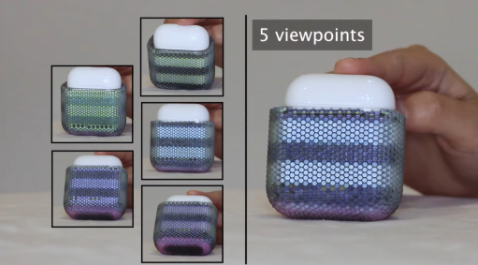Introduction: Researchers at the Massachusetts Institute of Technology (MIT) have developed a new method of 3D printing objects that can change their appearance depending on the angle of viewing.
The approach paves the way for “programmable objects” with deformable images, a visual feature previously largely limited to flat 2D surfaces. The team believes their work could revolutionize the way people design the appearance of products, with 3D-printed objects potentially containing hundreds of different colors and patterns, depending on which direction people look.
“Our work opens up the idea of what physical objects can be,” said Yunyi Zhu, an MIT graduate student and co-first author of the paper. “This is part of a larger vision of making dynamic objects that can change their appearance, color pattern and shape. We address appearance, which is one dimension of the concept of reprogrammable objects.”

So how does it work? The novelty of the idea is that it uses 3D printed lenticular lenses, tiny lenses that magnify the color of the material they are placed on. Depending on the angle of viewing, lenticular lenses can diffract and project different areas of the image or pattern they cover. The MIT team managed to fit six of these lenses on the surface of the design cell. By 3D printing the lens (and the curved, patterned surface beneath the lens), it is possible to create a complete 3D lens display that collectively displays an image that changes depending on the viewpoint.
According to Zhu, the biggest challenge of the project was fine-tuning the dimensions of the printed lenses. Smaller lenses offer better resolution, but also tend to have more defects, resulting in lower image quality. The team finally settled on a lens diameter of 3mm.

To complement 3D printing technology, MIT researchers have also developed a free editor
software
, which allows users to design and build their own lens objects. To use the tool, the user simply uploads the 3D model and the desired pattern or image of the object’s surface. The software then automatically calculates the lens position and pattern that will achieve the desired result. Parts, images and lenses can all be 3D printed in one pass.
To demonstrate the lens 3D printing method, the team has printed a number of prototypes. This includes an exercise kettlebell that shows users if they’re holding it correctly, a bedside lampshade that says “Good Day” or “Good Night” depending on the viewing angle, a flashing AirPod case, and a friendly message dedicated to the wearer .
The extraordinary minds of MIT have been the source of several 3D printing innovations over the years. Just this month, researchers at the university developed a new method of using 3D printing technology to invisibly embed information into physical objects. The concept is named “InfraredTags” and it’s about embedding infrared readable barcodes and QR codes inside 3D printed parts. These tags are only visible to dedicated infrared sensors and are designed to be invisible to the naked eye.
MIT researchers have also developed a method for 3D printing objects that can sense user interaction. The novelty is that these objects are made of a monolithic material (or more precisely a metamaterial)3D printingYes, the electrode sensor is integrated into the material structure itself. As a result, the printed structures are able to detect various state changes, including applied force and rotation.
(responsible editor: admin)


0 Comments for “MIT researchers design 3D structures based on changing viewing angles by 3D printing”